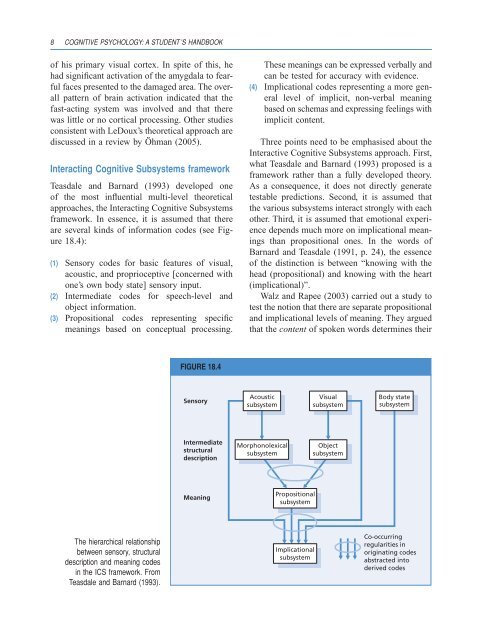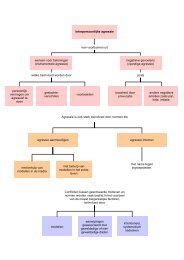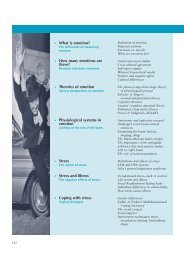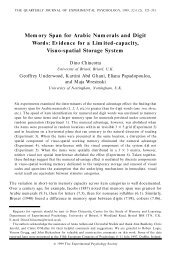Chapter 18: Cognition and Emotion - Psychology Press
Chapter 18: Cognition and Emotion - Psychology Press
Chapter 18: Cognition and Emotion - Psychology Press
You also want an ePaper? Increase the reach of your titles
YUMPU automatically turns print PDFs into web optimized ePapers that Google loves.
8 COGNITIVE PSYCHOLOGY: A STUDENT ’S HANDBOOK<br />
of his primary visual cortex. In spite of this, he<br />
had significant activation of the amygdala to fearful<br />
faces presented to the damaged area. The overall<br />
pattern of brain activation indicated that the<br />
fast-acting system was involved <strong>and</strong> that there<br />
was little or no cortical processing. Other studies<br />
consistent with LeDoux’s theoretical approach are<br />
discussed in a review by Öhman (2005).<br />
Interacting Cognitive Subsystems framework<br />
Teasdale <strong>and</strong> Barnard (1993) developed one<br />
of the most influential multi-level theoretical<br />
approaches, the Interacting Cognitive Subsystems<br />
framework. In essence, it is assumed that there<br />
are several kinds of information codes (see Figure<br />
<strong>18</strong>.4):<br />
(1) Sensory codes for basic features of visual,<br />
acoustic, <strong>and</strong> proprioceptive [concerned with<br />
one’s own body state] sensory input.<br />
(2) Intermediate codes for speech-level <strong>and</strong><br />
object information.<br />
(3) Propositional codes representing specific<br />
meanings based on conceptual processing.<br />
The hierarchical relationship<br />
between sensory, structural<br />
description <strong>and</strong> meaning codes<br />
in the ICS framework. From<br />
Teasdale <strong>and</strong> Barnard (1993).<br />
FIGURE <strong>18</strong>.4<br />
Sensory<br />
Intermediate<br />
structural<br />
description<br />
Meaning<br />
These meanings can be expressed verbally <strong>and</strong><br />
can be tested for accuracy with evidence.<br />
(4) Implicational codes representing a more general<br />
level of implicit, non-verbal meaning<br />
based on schemas <strong>and</strong> expressing feelings with<br />
implicit content.<br />
Three points need to be emphasised about the<br />
Interactive Cognitive Subsystems approach. First,<br />
what Teasdale <strong>and</strong> Barnard (1993) proposed is a<br />
framework rather than a fully developed theory.<br />
As a consequence, it does not directly generate<br />
testable predictions. Second, it is assumed that<br />
the various subsystems interact strongly with each<br />
other. Third, it is assumed that emotional experience<br />
depends much more on implicational meanings<br />
than propositional ones. In the words of<br />
Barnard <strong>and</strong> Teasdale (1991, p. 24), the essence<br />
of the distinction is between “knowing with the<br />
head (propositional) <strong>and</strong> knowing with the heart<br />
(implicational)”.<br />
Walz <strong>and</strong> Rapee (2003) carried out a study to<br />
test the notion that there are separate propositional<br />
<strong>and</strong> implicational levels of meaning. They argued<br />
that the content of spoken words determines their<br />
Acoustic<br />
subsystem<br />
Morphonolexical<br />
subsystem<br />
Propositional<br />
subsystem<br />
Implicational<br />
subsystem<br />
Visual<br />
subsystem<br />
Object<br />
subsystem<br />
Body state<br />
subsystem<br />
Co-occurring<br />
regularities in<br />
originating codes<br />
abstracted into<br />
derived codes





